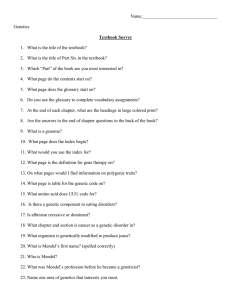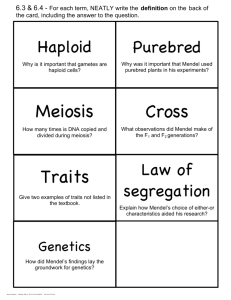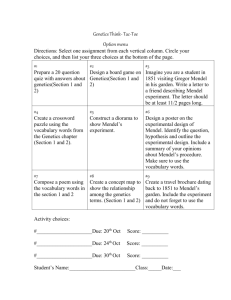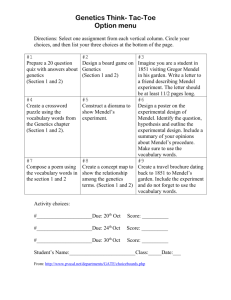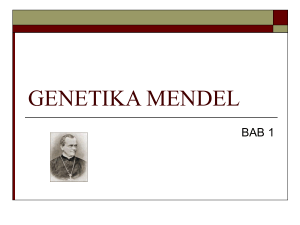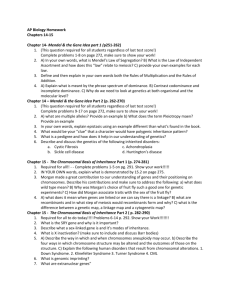Document 13471540
advertisement
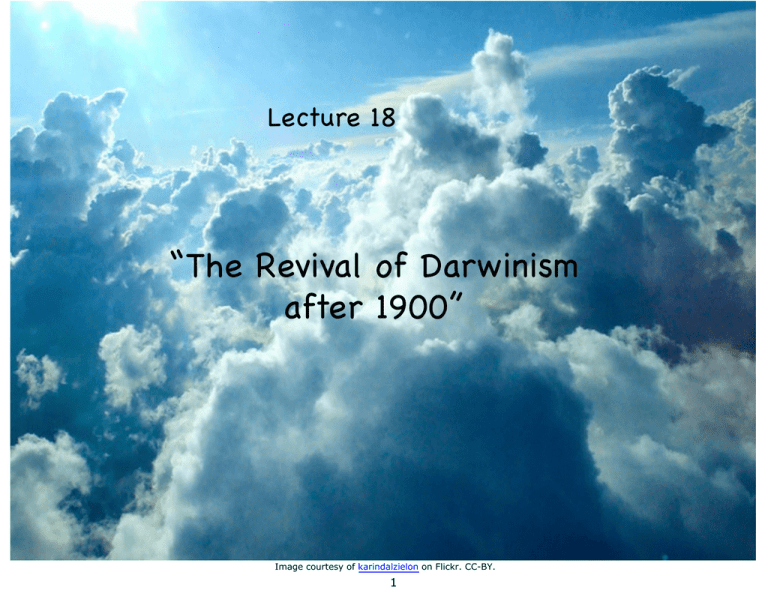
Lecture 18 “The Revival of Darwinism after 1900” Image courtesy of karindalzielon RQFlickr. CC-BY. Scopes Trial: Legacy What actually happened?? Who “really” won and lost?? What actually happened? • The trial attracted huge press coverage • Dayton, Tennessee became a laughing stock nationally & internationally • Scopes was duly convicted (but the verdict was later quashed on a technicality) • But there was a widespread perception that Darrow had made a fool of him (tragically, Bryan died shortly after the trial) • Tennessee’s Butler Act stayed on the statute books, but it and other state “monkey laws” fell into disuse So who really won and lost? • Darrow and ACLU won because – Bryan and Dayton were made to look foolish – Scopes got off on a technicality – Other “monkey laws” were not acted upon after 1925 • Bryan and State of Tennessee won because: – Scopes was convicted – Other monkey laws stayed on the statue books through the 1960s – These monkey laws were not acted upon largely because evolution was not taught in the public schools until the 1960s The Revival of Darwinism after 1900 • Self-styled “neo-Darwinists” put up strong resistance to non-Darwinian theorizing in the late-19th century • Many, like Darwin & Wallace, were field naturalists and bio-geographers • One exception was the German laboratory biologist August Weismann, who fought a hard campaign against “Lamarckian” inheritance based on both theoretical and experimental grounds • Weismann championed a key neo-Darwinian concept: “the continuity of the germ plasm” August Weismann, 1834-1914 Professor of Zoology, University of Freiburg, Germany, and author of “germ plasm” theory, the first explicitly anti-Lamarckian theory of inheritance The situation in biology in 1900 • A plethora of alternative theories of the mechanism of evolution • Neo-Darwinians vied with neo-Lamarckians, orthogeneticists and mutationists • No-one had a clear idea about how any of these candidate mechanisms actually worked • Meanwhile, the one person who had provided a clue to the solution of this problem went almost entirely unnoticed Gregor Mendel, 1822-1884 • Moravian Augustinian monk • Undertook crossing experiments on pea plants in monastery gardens • Published results in the 1860s suggesting the existence of discrete “factors” determining inherited characteristics • Widely ignored in his lifetime • Achieved posthumous fame when his work was multiply “rediscovered” around 1900 Mendel’s experiments Arguably the most famous experiments in the history of biology, Mendel’s hybridization experiments with pea plants laid the foundations for the modern science of genetics. Mendel’s originality…and obscurity Originality:? • Perfected hybridization technique on a single plant • Developed “purebreeding” strains that differed in respect of 7 discrete characters Obscurity:? • Performed thousands of systematic crosses Gregor Mendel, “Versuche über PflanzenHybriden” [Experiments on Plant Hybridization], Verh. Naturforsch. Ver Brünn [Proceedings of the Natural History Society of Brünn], 4 (1866), 3-47 • Followed outcomes over several generations • Quantified his results Reprinted in: Journal of the Royal Horticultural Society, 26 (1901), pp. 1-32 Mendel’s experiments This image is in the public domain. Mendel’s laws? Segregation Independent assortment When any individual produces gametes, the two copies of each gene separate so that each gamete receives only one; i.e., a gamete receives one allele or the other? Alleles of different genes assort independently of one another during gamete formation? The re-discovery of Mendel’s work • Mendel’s work was not generally appreciated in his life-time • It’s not clear whether Mendel himself thought his results were generally applicable • Around 1900, research aimed at finding a theory of discontinuous inheritance led to independent duplication of Mendel’s work by 3 scientists: – Hugo de Vries – Carl Correns – Erich von Tschermak • William Bateson took up the cause, coining the terms “genetics” in 1905 Initial responses to Mendelian genetics • The most striking feature of the new Mendelian genetics was that it was a theory of discontinuous rather than blending inheritance. Particulate genes passed down the generations unblended and undiluted, subject only to occasional “mutations”. • In 1900, “mutations” were widely thought of as candidate sources of sudden or “saltatory” evolutionary change; a “mutation” was presumed to be an inherited change of large effect capable of transforming one species into another. • Thus, for many people the first associations of the new Mendelism were anti-Darwinian Biometry versus Mendelism Biometricians Mendelians • Led by Karl Pearson & W. R. Weldon • Emphasis on analysis of continuous variation • Claimed superior mathematical rigor • Assumed by many to be compatible with Darwinian gradualism • Led by William Bateson & Thomas Hunt Morgan • Emphasis on analysis of discontinuous variation • Claimed superior biological understanding • Assumed by many to be incompatible with Darwinian gradualism Thomas Hunt Morgan, 1866-1945 • American embryologist & geneticist • Set up famous “fly room” at Columbia University, to study mutations in the fruit fly Drosophila melanogaster • Demonstrated that genes are carried on chromosomes, which are the physical basis of heredity • Won Nobel Prize for Physiology & Medicine in 1933 Morgan establishes 1st “model organism” Sex linked inheritance of “white eyed” mutation Breeding of Drosophila melanogaster flies in jars Photograph by sylverwytche on Flickr. CC-BY. Photo courtesy of adactio on Flickr. CC-BY. Morgan’s changing views on evolution • Interested in evolution throughout his career • Started out skeptical about Mendelism and Darwinian natural selection • Fly room work gradually changed his mind on both counts: 1. Satisfied himself that Mendel’s laws apply, and that chromosomes are physical basis of Mendelian inheritance 2. Established the existence of many small, stable, heritable mutations 3. Realized that such mutations were the raw material for Darwinian evolution by natural selection • "Evolution has taken place by the incorporation into the race of those mutations that are beneficial to the life and reproduction of the organism” (1916) 4/26/12 Unifying Mendelism and Darwinism: population genetics MendelMorgan Theory (1900-1915) • Behavior of genes and chromosomes in laboratory bred families of animals • Basic mechanisms of inheritance and variation • Not favorably disposed towards Darwinian natural selection Population genetics (1915-1935) • Mendel-Morgan theory applied to (idealized) reproducing populations • Statisticical characterization of behavior of genes in “gene pools” • Increasingly focused on natural selection as key mechanism of evolutionary change Population genetics was principally the achievement of three mathematical biologists; Ronald Fisher; J. B. S. Haldane; and Sewall Wright Ronald Fisher, 1890-1962 • English statistician, evolutionary biologist, geneticist & eugenicist • “The greatest of Darwin’s successors” (Richard Dawkins) • Author of The Genetical Theory of Natural Selection, 1930 J. B. S. (“Jack”) Haldane, 1892-1964 • British geneticist, evolutionary biologist, political agitator & writer • Wrote a series of 10 papers on “A Mathematical Theory of Natural and Sexual Selection” (1924-34) • Considerable popularizer of science in regular column for Daily Worker newspaper This image is in the public domain. Sewall Green Wright, 1889-1988 • American geneticist & evolutionary biologist • Wrote “The roles of mutation, inbreeding, crossbreeding and selection in evolution” (1934) • Developed notion of the “adaptive landscape” • Inspired a distinctively American school of (NeoDarwinian) evolutionary biology Defining some key terms: “selection” Natural selection: Coefficient of selection: "The process by which traits become more or less common in a population due to consistent effects upon the survival or reproduction of their bearers. "A measure of the extent to which natural selection is acting to reduce the relative contribution of a given genotype to the next generation. Denoted as s, the selection coefficient is a number between zero and one. 4/26/12 Defining some key terms: “fitness” • Haldane was the first to quantify biological fitness in 1924 • “Absolute fitness” (wabs) of a genotype is the ratio between the number of individuals with that genotype after selection to those before selection: ""Fitness is a property, not of an individual, but of a class of individuals – for example homozygous for allele A at a particular locus. Thus the phrase ’expected number of offspring’ means the average number, not the number produced by some one individual. If the first human infant with a gene for levitation were struck by lightning in its pram, this would not prove the new genotype to have low fitness, but only that the particular child was unlucky.” John Maynard Smith 4/26/12 “Fundamental Theorem of Natural Selection” " The rate of increase in fitness of any organism at any time is equal to its genetic variance in fitness at that time.” Ronald Fisher Sewall Wright’s “adaptive landscape” • Problem of “local optima – How to get from peak to peak? • Role of “genetic drift” – Drift can drive small, isolated populations into valleys • “Shifting balance” theory Theodosius Dobzhansky, 1900-1975 • Russian (Ukrainian), emigrate d to the U.S. in 1927 • Student of T. H. Morgan, did both laboratory & field studies of Drosophila • Influenced by Sewall Wright’s “shifting balance” theory • Wrote Genetics and the Origin of Species (1937), which defined evolution as ""a change in the frequency of an allele within a gene pool” The “Modern Synthesis” (1930s-40s) "“Experience seems to show…that there is no way toward an understanding of the mechanisms of macroevolutionary changes, which require time on a geological scale, other than through a full comprehension of the micro-evolutionary processes observable within the span of a human lifetime and often controlled by man’s will.” Dobzhansky, Genetics and the Origin of Species, 1937 MIT OpenCourseWare http://ocw.mit.edu STS.009 Evolution and Society Spring 2012 For information about citing these materials or our Terms of Use, visit: http://ocw.mit.edu/terms.
